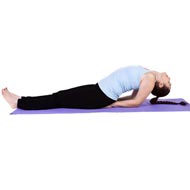- Sun Salutation
- Headstand
- Inverted Triangle Pose
- Hand to Foot Pose
- Lion Pose
- Head to One Knee Pose
- Head to Knees Pose
- Camel Pose
- Sage Marichi Twist Pose
- Inverted Leg Stretch Pose
- Shoulder Stand
- Plough Pose
- Inclined Plane
- Boat Pose
- Fish Pose
- Wheel Pose
- Bridge Pose
- Downward Facing Dog Pose
- Cobra Pose
- Bow Pose
- Locust Pose
- Eagle Pose
- Peacock Pose
- Crow Pose
- Corpse Pose
- Yoga Balance Asanas
- Yoga Asanas For Spine
- Yoga Asanas in Chair
- Basic Yoga Asanas For Stomach
- Yoga Asanas For The Neck
- Yoga Asanas For Depressed
- Yoga Asanas For Beginners
- Sequencing Yoga Asanas
- One Legged King Pigeon Pose - Eka Pada Rajakapotasana
- Reclining Bound Angle Pose - Supta Baddha Konasana
- Eight Angle Pose - Astavakrasana
- Hand Clenching
- Side Crane Pose - Parsva Bakasana
- Ankle Rotation
- Circle pose - Mandalasana
- Dolphin Plank Pose
- Half Frog Pose - Ardha Bhekasana
- Four-Limbed Staff Pose - Chaturanga Dandasana
- Extended Puppy Pose - Uttana Shishosana
- Supported Headstand - Salamba Sirsasana
- Pendant Pose - Lolasana
- Shoulder-Pressing Pose - Bhujapidasana
- Ankle Bending
- Wrist Bending
- Standing Half Forward Bend
- Side-Reclining Leg Lift
- Standing Yoga Seal
- Shiva Twist
- Upward Salute
- Intense Side Stretch Pose
- Wild Thing
- Great Hand Posture
- Upward Bow
- Warrior Seal
- Spread Leg Forward Fold
- Legs-Up-the-Wall Pose
- King Pigeon Pose
- Arm Pressing Posture
- Upward-Facing Dog
- Crocodile Pose
- Feathered Peacock Pose
- Reclining Angle Pose
- Reclining Hero Pose
- Half Headstand Pose
Half Lord of The Fish Pose - Ardha Matsyendrasna
The “Half Lord of the Fish Pose” (Ardha Matsyendrasana) is a spinal twist. This yoga pose owes its name to a legendary yoga teacher.
There are a number of benefits associated with this intense spinal twist, and this spinal twist also has a number of therapeutic applications. It is primarily helpful in providing relief to conditions relating to the back and the spinal cord.
The Half Lord of the Fish Pose
As mentioned earlier, the "Half Lord of the Fish Pose" (Ardha Matsyendrasana) is a seated spinal twist. This yoga pose has a specific purpose, which is to strengthen and stretch the spinal cord and back. It also stimulates the digestive organs and thus makes the digestive system more efficient. Other than this, there are a number of benefits that the practitioner experiences on practicing this pose.
Steps
The following are the Half Lord of the Fish Pose:
- The first step is to sit on a yoga mat with your legs straight and spread outwards. Use a folded blanket and support your buttocks on the blanket. Now bend both your knees and put your feet on the floor. Next, slowly slide your left foot under your right leg and reach for the outside of the right hip with your left foot. You must lay the outside of the left leg on the floor after sliding it. Now cross your right leg over the left leg and make it stand with your right foot resting on the floor. Make sure that the right knee is pointing towards the ceiling.
- Keep the right hand against the floor just behind your buttock and press it on the floor. Now simultaneously exhale and twist in the direction of the inner portion of the right thigh. Keep your left upper arm on the right knee which is pointing upwards. Now pull your torso and the right thigh together.
- Next, press the inner right foot into the floor and simultaneously release the right groin. Also, lengthen the right torso. Continue to lengthen the tailbone while you lean the upper torso back only slightly.
- Turn your head in any of the two directions. You can choose to continue to twist the torso while you turn it to the right or you can counter the twist of the torso by turning it to the left. When you are turning your torso to the left, you must look over the left shoulder towards the right foot.
- As you inhale, with every breath you should lift a little through the sternum. For aid, you can press the fingers against the floor. With every exhalation twist a little more. You must ensure that you spread the twist evenly throughout the spine and it is not concentrated at any particular area of the spine. Stay in the pose for about 30 seconds to 1 minute, and then release with an exhalation and return to the initial starting position. Now repeat this pose for the left side for the same time duration.
Precautions
There are a few Half Lord of the Fish Pose precautions that the practitioner should know about in order to prevent any injury while doing the pose.
- Those who have a spinal injury must not perform this pose.
- Those who have back pain and wish to perform this spinal twist must do so under the supervision of professionals.
A Beginner's Tip
This beginner's tip for "The Half Lord of the Fish Pose" will help you in performing this deep spinal twist with ease. Beginners might find it difficult to wrap the opposite arm around the raised leg. This can also prove to be potentially harmful for the beginners. So, initially beginners can just wrap the arm around the raised leg and bring the thigh closer to the torso so as to hug it close. Additionally, start by holding the pose for only as long as it is comfortable for you. The duration of yoga poses always depends on the comfort level of the practitioner.
Benefits to the body
The "Half Lord of the Fish Pose" has many benefits to body parts. Below is a list of the benefit to body part:
- It stimulates the liver and kidney, thus regulating their functioning.
- It strengthens the spine.
- It stimulates the digestive organs and thus helps in the improvement of digestion.
Therapeutic applications
The therapeutic applications of “The Half Lord of the Fish” yoga pose are many. Mentioned below are a few therapeutic applications of this spinal twist:
- The pose can be applied for treating curing asthma and infertility.
- Practicing this pose helps relieve the discomfort felt during menstruation, or PMS.
- The pose can be used to treat sciatica, backaches, and other aches and pains.
- The pose is helpful in tackling fatigue.
Variations
There are a few variations for “The Half Lord of the Fish Pose” that the practitioners can try. Variations are used either to make the pose more challenging or to make it easier to perform. A few variations are as follows.
To decrease the intensity of the spinal twist the practitioner can:
- Keep the foot on the inside of knee.
- Keep the lower leg straight while the upper foot is on the inside or outside of leg.
- Bend or straighten the knee according to the comfort.
- Try lifting the chest so as to straighten the spine.
Those who have practiced the pose sufficiently and feel comfortable in performing the pose can choose to deepen the pose by intensifying it.
Preparatory poses
Preparatory Poses for Half Lord of the Fish Pose are as follows:
- Bound Angle Pose (Baddha Konasana)
- Head-to-Knee Forward Bend (Janu Sirsasana)
- Reclining Big Toe Pose (Supta Padangusthasana)
- Hero Pose (Virasana)
- Bharadvaja's Twist (Bharadvajasana)
These poses prepare the body for an intense twist such as this.
Follow up poses
The follow up poses for Half Lord of the Fish pose are
- Head-to-Knee Forward Bend (Janu Sirsasana)
- Seated Forward Bend (Paschimottanasana)
These follow up poses help to eliminate the stress experienced by the various body parts after performing the pose.
 Find Pose
Find Pose

